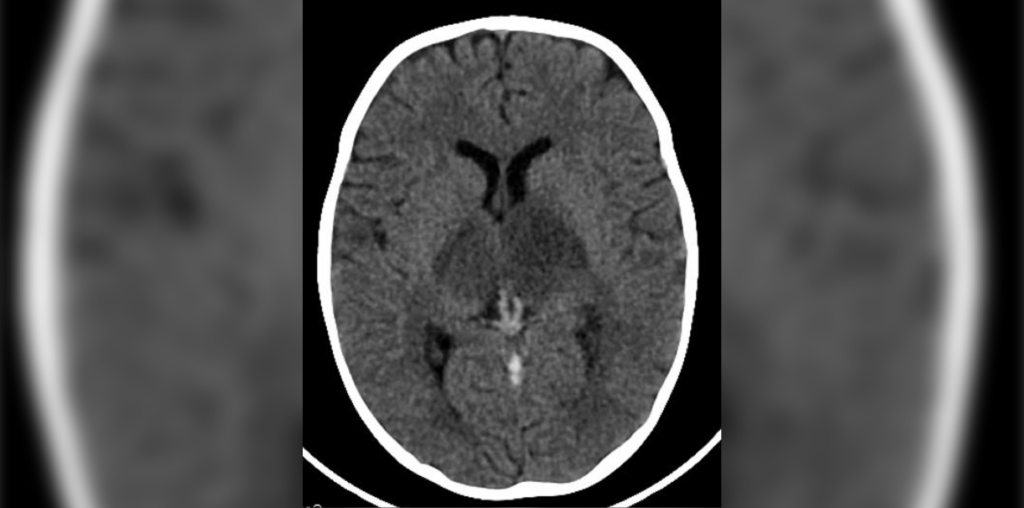
Learning Objectives
- Recognize venous sinus thrombosis as an important cause of young stroke
- Recognize the urgency of anticoagulation to treat these patients
A 37-year-old cis woman presents with confusion and fluctuating level of consciousness. She was previously heathy and using an oral contraceptive pill. On examination, she opens her eyes to painful stimuli, mumbles certain phrases in response to questions, and has vertical gaze palsy with poor withdrawal of limbs to painful stimuli. CT head showed bilateral thalamic hypodensity.
On closer review, hyperdensity of the internal cerebral veins (seen below the thalami on the image) can be seen. Thrombosis of the internal cerebral veins is suspected, and the patient undergoes a CT venogram which confirms thrombosis of these veins. The patient is initiated on anticoagulation with intravenous unfractionated heparin and is closely monitored on a neurocritical care unit.
She is, fortunately, able to maintain her airway and is breathing independently, and as the thrombosis gradually clears, her level of consciousness improves over the subsequent week and she is able to participate in an inpatient rehabilitation program. She is transitioned to oral anticoagulation with rivaroxaban. Investigation by hematology reveals a factor V Leiden mutation. The oral contraceptive pill is stopped, and she decides to use an intrauterine device instead for contraception.
Identifying Cerebral Venous Thrombosis
Cerebral venous thrombosis or venous sinus thrombosis is a very important cause of young stroke. These patients can have a variety of clinical presentations including headaches, seizures, encephalopathy, and focal neurological deficits. The “dense vein sign” refers to hyperattenuating thrombus within a cortical or cerebral vein or dural venous sinus due to acute venous thrombosis, as also seen in this case. This sign is an important clue that can help prompt consideration of cerebral venous thrombosis. Internal cerebral venous thrombosis is a rare but especially important form of cerebral venous thrombosis as it can cause bilateral venous infarcts of the thalamus, similar to that seen in this case.
Given the critical role that the thalami play in maintaining our level of consciousness, these patients can present with different levels of altered consciousness or even deep coma. The condition is crucial to recognize as it must be treated with anticoagulation as the first-line management to help clear the venous thrombi and prevent further venous infarctions and hemorrhage. Common precipitants of the condition include dehydration and intercurrent infection, but investigating for causes of venous hypercoagulability can be particularly useful when there is no clear precipitant. Oral contraceptive pills have been associated with an increased risk of venous sinus thrombosis.
Further Reading
Evaluation and Management of Cerebral Venous Thrombosis
References
Crawford SC, Digre KB, Palmer CA, et al. Thrombosis of the deep venous drainage of the brain in adults. Analysis of seven cases with review of the literature. Arch Neurol 1995;52(11):1101-1108. doi: 10.1001/archneur.1995.00540350095021.
Majersik JJ. Inherited and Uncommon Causes of Stroke. Continuum (Minneap Minn) 2017;23(1, Cerebrovascular Disease):211-237.

Aravind Ganesh, MD, DPhil(Oxon), FRCPC
Vascular and Cognitive Neurologist and Assistant Professor, University of Calgary Department of Clinical Neurosciences
Published March 8, 2023
Want more clinical cases?
Join Figure 1 for free and start securely collaborating with other verified healthcare professionals on more than 100,000 real-world medical cases just like this one.